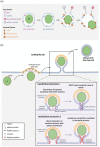Orientia tsutsugamushi: A life between escapes
- PMID: 37877457
- PMCID: PMC10493369
- DOI: 10.1002/mbo3.1380
Orientia tsutsugamushi: A life between escapes
Abstract
The life cycle of the mite-borne, obligate intracellular pathogen Orientia tsutsugamushi (Ot), the causative agent of human scrub typhus, differs in many aspects from that of other members of the Rickettsiales order. Particularly, the nonlytic cellular exit of individual Ot bacteria at the plasma membrane closely resembles the budding of enveloped viruses but has only been rudimentarily studied at the molecular level. This brief article is focused on the current state of knowledge of escape events in the life cycle of Ot and highlights differences in strategies of other rickettsiae.
Keywords: Orientia tsutsugamushi; budding; phagosomal escape; scrub typhus.
© 2023 The Authors. MicrobiologyOpen published by John Wiley & Sons Ltd.
Conflict of interest statement
None declared.
Figures


Similar articles
-
Obligate intracellular bacteria diversity in unfed Leptotrombidium scutellare larvae highlights novel bacterial endosymbionts of mites.Microbiol Immunol. 2020 Jan;64(1):1-9. doi: 10.1111/1348-0421.12745. Epub 2019 Oct 23. Microbiol Immunol. 2020. PMID: 31549736
-
Variable clinical responses of a scrub typhus outbred mouse model to feeding by Orientia tsutsugamushi infected mites.Exp Appl Acarol. 2012 Sep;58(1):23-34. doi: 10.1007/s10493-012-9563-8. Epub 2012 Apr 24. Exp Appl Acarol. 2012. PMID: 22527840
-
Orientia tsutsugamushi.Trends Microbiol. 2020 Sep;28(9):780-781. doi: 10.1016/j.tim.2020.02.014. Epub 2020 Mar 23. Trends Microbiol. 2020. PMID: 32781029 No abstract available.
-
Classification of Rickettsia tsutsugamushi in a new genus, Orientia gen. nov., as Orientia tsutsugamushi comb. nov.Int J Syst Bacteriol. 1995 Jul;45(3):589-91. doi: 10.1099/00207713-45-3-589. Int J Syst Bacteriol. 1995. PMID: 8590688 Review.
-
Orientia tsutsugamushi DNA load and genotypes in blood as a marker of severity.Acta Trop. 2021 Mar;215:105786. doi: 10.1016/j.actatropica.2020.105786. Epub 2020 Dec 9. Acta Trop. 2021. PMID: 33309595 Review.
Cited by
-
Scrub Typhus and Bilateral Lateral Rectus Palsy: An Uncommon Manifestation.Cureus. 2024 Sep 21;16(9):e69891. doi: 10.7759/cureus.69891. eCollection 2024 Sep. Cureus. 2024. PMID: 39439614 Free PMC article.
-
Orientia tsutsugamushi modulates p53, the cell cycle, and genotoxicity to maintain its intracellular niche.Nat Commun. 2025 Aug 19;16(1):7728. doi: 10.1038/s41467-025-63149-z. Nat Commun. 2025. PMID: 40830139 Free PMC article.
References
-
- Antonny, B. , Burd, C. , De Camilli, P. , Chen, E. , Daumke, O. , Faelber, K. , Ford, M. , Frolov, V. A. , Frost, A. , Hinshaw, J. E. , Kirchhausen, T. , Kozlov, M. M. , Lenz, M. , Low, H. H. , McMahon, H. , Merrifield, C. , Pollard, T. D. , Robinson, P. J. , Roux, A. , & Schmid, S. (2016). Membrane fission by dynamin: What we know and what we need to know. The EMBO Journal, 35, 2270–2284. - PMC - PubMed
-
- Atwal, S. , Wongsantichon, J. , Giengkam, S. , Saharat, K. , Pittayasathornthun, Y. J. , Chuenklin, S. , Wang, L. C. , Chung, T. , Huh, H. , Lee, S. H. , Sobota, R. M. , & Salje, J. (2022). The obligate intracellular bacterium Orientia tsutsugamushi differentiates into a developmentally distinct extracellular state. Nature Communications, 13, 3603. - PMC - PubMed
Publication types
MeSH terms
LinkOut - more resources
Full Text Sources

